NIST security controls provide a systematic framework for conducting effective penetration testing through Special Publication 800-53.
The controls specifically address penetration testing under control SA-11(5) “Security and Privacy Testing | Penetration Testing”.
Key Requirements for Penetration Testing Under NIST
- Employing controlled penetration testing that mimics adversary attacks
- Testing both the physical and logical boundaries of systems/components
- Defining clear rules of engagement
- Coordinating penetration testing activities across the organization
Implementation Steps
- Planning Phase
- Document scope and objectives
- Obtain proper authorizations
- Define testing boundaries
- Execution Phase
- Follow approved testing procedures
- Document all findings
- Maintain detailed activity logs
- Reporting Phase
- Analyze results
- Prioritize vulnerabilities
- Provide remediation recommendations
Control Enhancement Requirements
| Control ID | Requirement |
|---|---|
| SA-11(5)(a) | Employ red team exercises |
| SA-11(5)(b) | Test physical security mechanisms |
| SA-11(5)(c) | Test insider threat detection capabilities |
Additional Resources
For questions about NIST security controls implementation, contact the Computer Security Division at [email protected].
Quick Tips for NIST-Compliant Penetration Testing
- Document every step of the testing process
- Use NIST-approved tools and methodologies
- Maintain separation between testing and production environments
- Schedule regular testing intervals based on system criticality
- Update testing procedures as new threats emerge
Testing Methodologies
Black Box Testing
- Limited prior knowledge of target systems
- Simulates external attacker perspective
- Tests external security controls
White Box Testing
- Complete system information provided
- In-depth security assessment
- Access to source code and architecture
Risk Management Integration
- Align testing with organizational risk tolerance
- Prioritize critical systems and assets
- Integrate findings into risk assessment process
- Update security controls based on results
Documentation Requirements
| Document Type | Required Content |
|---|---|
| Test Plans | Scope, methodology, schedule |
| Results Report | Findings, evidence, impact ratings |
| Remediation Plan | Solutions, timelines, responsibilities |
Conclusion
Effective implementation of NIST-compliant penetration testing requires systematic planning, execution, and documentation. Organizations must:
- Maintain continuous alignment with NIST guidelines
- Regularly update testing procedures
- Ensure proper resource allocation
- Foster collaboration between security teams
- Integrate findings into overall security program
Success depends on balancing technical requirements with organizational objectives while maintaining compliance with NIST security controls framework.
FAQs
- What are NIST security controls for penetration testing?
NIST security controls for penetration testing are guidelines outlined in NIST Special Publication 800-53, specifically in control CA-8. These controls provide requirements and procedures for conducting security testing to identify vulnerabilities in systems and applications. - How frequently should penetration testing be performed according to NIST?
NIST recommends conducting penetration testing at least annually for high-impact systems and when significant changes occur to the system, its environment, or when new threats and vulnerabilities are identified. - What are the different types of penetration testing covered by NIST controls?
NIST covers white-box (full knowledge), black-box (zero knowledge), and gray-box (partial knowledge) testing approaches, as well as external, internal, and specialized testing focused on specific components or security controls. - What documentation is required for NIST-compliant penetration testing?
Documentation must include test plans, methodologies, results, remediation recommendations, and post-test analysis. All findings must be formally reported and tracked through the organization’s vulnerability management process. - Who should perform NIST-compliant penetration testing?
Testing should be performed by qualified and authorized individuals or teams, either internal or external, who have appropriate security clearances and documented testing capabilities. Testers must be independent of the system development and maintenance teams. - What systems require penetration testing under NIST guidelines?
Systems categorized as high-impact under FIPS 199, systems processing sensitive information, internet-facing systems, and critical infrastructure systems require penetration testing according to NIST guidelines. - How does NIST define the scope of penetration testing?
NIST requires the scope to include network infrastructure, applications, physical security controls, and social engineering aspects when applicable. The scope must be clearly defined and approved before testing begins. - What are the key NIST requirements for handling penetration test results?
Results must be properly classified, securely stored, shared only with authorized personnel, and used to develop remediation plans. Findings must be tracked until resolution and verified through subsequent testing. - How does NIST address specialized penetration testing requirements?
NIST includes provisions for specialized testing such as Red Team exercises, adversary emulation, and focused testing of critical system components or security mechanisms based on specific threat scenarios. - What coordination is required for NIST-compliant penetration testing?
Testing must be coordinated with appropriate organizational officials, system owners, and stakeholders. Proper notifications, authorizations, and emergency procedures must be established before testing begins.







